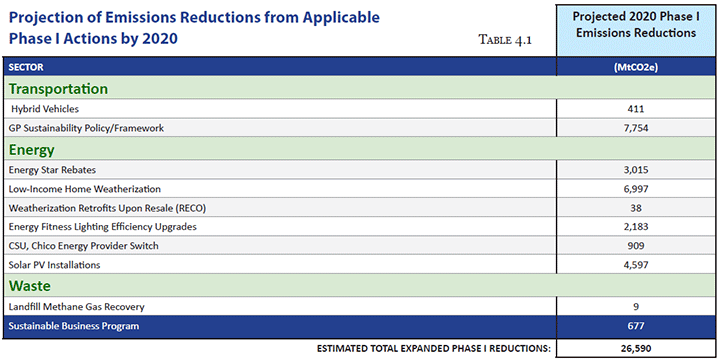Review of Phase I
Prior to the end of 2015, a review and evaluation of Phase I actions will be conducted so that, if necessary, a CAP amendment can be completed prior to the beginning of Phase II in 2016.
The CAP review will assess the successes and/or shortcomings of implementing Phase I actions. Using the results of the second GHG Inventory, the review will evaluate the degree to which external and local actions influenced emissions levels compared with the estimates originally made in the CAP. Any actions taken independently of the CAP by individuals and businesses during Phase I that were not accounted for in the CAP will also be identified and quantified if possible.
The review will also analyze the dynamic circumstances surrounding the CAP, and consider how they affected the implementation of Phase I. These circumstances may include: the condition of the local economy; input price levels (ranging from gasoline and kWh of energy to efficient technologies); relevant and available technologies; and funding sources for implementation. A careful evaluation of the Phase I results and the circumstances impacting them will help ensure that any adjustments made to the CAP for Phase II are most relevant and likely to steer the CAP toward meeting its 2020 goal.
Preparing for Phase II and CAP Amendment
Depending upon the Phase I outcome as determined by the second GHG Inventory and the CAP review, it may be necessary to adjust the amount of emissions reductions needed during Phase II to reach the targeted 2020 GHG emissions level of 385,749 MtCO2e. If changes to the Phase II emissions reductions goals are needed for external and/or local actions, they will be established through the CAP amendment.
Estimation of Potential External Impacts in Phase II
To determine the level of local GHG reduction needed for the amendment, the City will first need to estimate the reductions from external actions in Phase II. Similar to Phase I, the reductions from external actions are anticipated to be primarily from changes in PG&E’s grid mix, increases in automobile fuel efficiency, the diversion rates of locally generated waste, and other measures implemented through California’s AB32 Scoping Plan.
Selection of Additional Actions
Many of the Phase I actions will continue to reduce GHG emissions during Phase II. It is projected that the continuation and/or expansion of all of the Phase I actions will collectively reduce GHG emissions by an estimated additional 26,590 MtCO2e per year by 2020.
The following Table 4.1 lists those Phase I actions for each sector that were projected to be expanded due to growth or other factors and the estimates of the additional projected annual GHG emissions reduction to be achieved between 2015 and 2020.

However, to meet the 2020 goal additional Phase II actions will be needed. Many are already included in this chapter, but others will likely be added through the CAP amendment process. New actions for Phase II may be selected by considering several of the following factors:
- Newly identified GHG reduction opportunities,
- Suggestions from the local community through public meetings,
- Policy direction in the Chico 2030 General Plan,
- Best practices from leading cities and organizations, and
- State and regional laws, guidelines, and recommendations.
The analysis of potential new Phase II actions will include determining the degree to which the action can be implemented, calculating an estimate of the potential emissions reduction, estimating the action’s related costs and savings, and identifying the likely implementer or implementers.
CAP Amendment
The amendment should be presented to the City Council and ready to implement by the beginning of Phase II in 2016. The amendment may require additional environmental review and will be adopted by the City Council through a public process.


